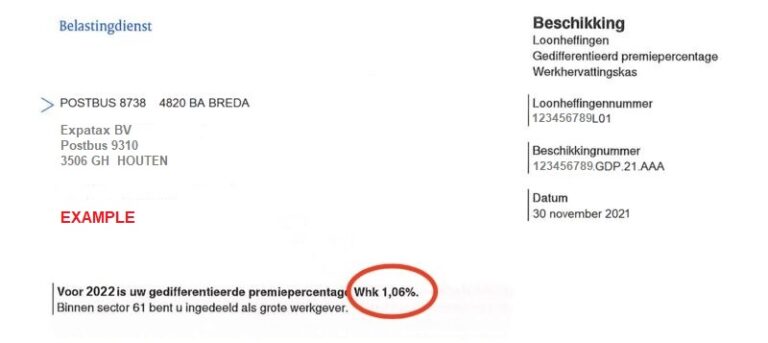Tax credits in the Dutch payroll administration

All amounts and percentages in this article are for the year 2021.
A tax credit is a discount on the wage and income tax and/or premiums social security of an employee or person entitled to benefits (hereinafter referred to as: employee). There are 8 tax credits. At the request of your employee, you as the employer, can take 6 of these tax credits – together referred to as the wage tax credit – into account when calculating the wage tax/national insurance contributions (see paragraph 1.1).
The employee can have all tax credits – including the wage tax credit – settled via his income tax return.
All tax credits are personal. Your employee cannot transfer them to someone else.
Tax credits and income tax
There are 2 tax credits that you do not take into account as employer: the employee has to settle these himself through the income tax. This can be done after the end of the year with the income tax return, but also in advance with a request for a provisional assessment. In that case, the employee will receive a monthly amount paid into his bankaccount.
These are the following tax credits:
- the income-related combination tax credit
- the tax credit for green investments
1.1 Wage tax credit
The wage tax credit is the collective name for the 6 tax credits that you take into account when determining the wage tax/national insurance contributions that you deduct from the wage. The wage tax credit can consist of the following tax credits:
- the general tax credit (see paragraph 1.1.1)
- the labour tax credit (see paragraph 1.1.2)
- the elderly tax credit (see paragraph 1.1.3)
- the single elderly tax credit (see paragraph 1.1.4)
- the young disabled person tax credit (see paragraph 1.1.5)
- the life-course leave tax credit (see paragraph 1.1.6)
Attention!
The life-course savings scheme was abolished on 1 January 2012. Employees can therefore no longer start saving in this scheme. Existing participants are subject to transitional rules.
Apply at the request of the employee
Every employee who meets the conditions is entitled to the wage tax credit. Your employee must ask you in writing to apply the wage tax credit, for example with a ‘Model opgaaf gegevens voor de loonheffingen’. If your employee no longer wants to or is not allowed to apply the wage tax credit with you, he must also inform you of this in writing.
There is an exception for the young disabled person tax credit: even if the employee does not have the wage tax credit applied with you, you may set off the young disabled person tax credit (see paragraph 1.1.5).
If the employee has not asked you to apply the wage tax rebate, he will not miss out: he can offset the wage tax credit via his income tax return.
In the payroll administration you state whether you are applying the wage tax credit. In addition, you indicate separately whether you apply the young disabled person tax credit.
Wage tax credit and payroll tax tables
The general tax credit and the elderly tax credit have been incorporated in the white and green tables. The employed person’s tax credit is only included in the white tables. The single elderly tax credit is only included in the green tables for the AOW, Anw and AIO benefits. So you do not have to calculate these 4 tax credits yourself. However, you do have to calculate the young disabled person tax credit and the life-course leave tax credit yourself.
What do you mean with white and green tables?
For the wage tax/premiums social security there are the following tables:
– White tables for wages from current employment
– Green tables for wages from previous employment
Depending on the type of wage, you therefore use the white or green tables.
ATTENTION!
Even if the employment has not yet ended the green tables for wages from previous employment may still apply. For example, in the case of a severance payment that you pay before the end of the employment.
The table for special remunerations has a column ‘settlement percentage wage tax credit’ for employees to whom you apply the wage tax credit. With this settlement percentage you apply the increase and decrease of the employed person’s tax credit and the decrease of the general tax credit to special remunerations.
Employees who are not fully liable to tax or social security premiums
The wage tax credit has a tax and a premium component. In the case of employees who are not liable for payroll tax or who are not (fully) liable to pay social security premiums, you must reduce the wage tax credit. For employees who have reached the state pension age, this reduction is included in the white and green tables. In 2021, the state pension age will be 66 years and 4 months.
Employees who are not residents of the Netherlands
All workers who are insured in the Netherlands for social security are entitled to the premium part of the wage tax credit. It does not matter for the premium part which country an employee is a resident of. Your employee is only entitled to the premium part of the tax credits for the period that he or she is insured in the Netherlands.
Until 2019, all employees were also entitled to the tax part of the wage tax credit. From 2019, however, only residents of the Netherlands are still entitled to it. Non-residents of the Netherlands are therefore no longer entitled to the tax part of the wage tax credit. When someone is a resident of the Netherlands, you can read in LINK. Your employee is only entitled to the tax part of the tax credits for the period that he is a resident of the Netherlands.
One tax credit, i.e. the employed person’s tax credit, is subject to an exception: residents of another EU Member State, of an EEA country (Iceland, Norway and Liechtenstein), Switzerland or a BES island (Bonaire, Sint Eustatius and Saba) are entitled to the tax part of this tax credit.
If the employee lives in Belgium, Surinam or Aruba, he or she is also entitled to the tax part of the general tax credit.
A seconded civil servant who is not actually resident in the Netherlands but who is deemed to remain a resident of the Netherlands may be treated the same as a resident of the Netherlands for the tax credits.
Employees with more than 1 employer or benefit agency
Only one employer or benefit agency may apply the wage tax credit. If the employee wants you to apply the wage tax credit, he must give you a written, signed request with date. If the employee does not have the wage tax credit applied to you, then you may only take the young disabled person tax credit into account.
If the employee has more than one employer or benefit agency, he may not be able to set off the full wage tax credit.
It is also possible that the employee chooses not to have the wage tax credit applied by any employer or benefit agency. The employee can then apply for a refund via his income tax return. Or with a request for a provisional assessment.
Wage tax tables
The new wage tax and premium tables can be found on belastingdienst.nl. The tables have been published in the Loonbelastingtabellen calculation aid. This calculation tool also includes the tables for the less common situations with a different tax or premium liability.
The calculation help can be found on belastingdienst.nl/tabellen. For older years the tables and the conversion rules can still be downloaded from belastingdienst.nl.
Since 2019 there are more wage tax tables. This is due to the distinction between residents and non-residents of the Netherlands for the tax credits and to adjustments in tax treaties.
1.1.1 General tax credit
The general tax credit will be phased out in 2021 by 5.977% of the income from work and home if this income is € 21,043 or more per year, but no more than € 68,507. In 2021, the general tax credit will be a maximum of € 2,837. The credit will be reduced to nil. If the employee has reached the state pension age, the maximum tax credit in 2021 is € 1,469. The credit will be reduced to nil.
The general tax credit and its reduction have been incorporated in the wage tax tables, the table for special remuneration and the calculation rules.
Attention!
With effect from 1 January 2019, the country of residence of your employee will be taken into account for the general tax credit. See paragraph 1.1 under ‘Employees who are not residents of the Netherlands’.
1.1.2 The employed person’s tax credit
An employee with wages from current employment is entitled to the employed person’s tax credit. The employed person’s tax credit is a percentage of that wage up to a maximum amount. The employed person’s tax credit is only calculated on periodic wages and not on one-off remunerations or remunerations that you only grant once a year, such as bonuses, tantièmes or holiday allowance. The table for special remunerations does take into account the increase and decrease of the employed person’s tax credit.
Attention!
– With effect from 1 January 2019, the country of residence of your employee will be decisive for the employed person’s tax credit. See paragraph 1.1 under ‘Employees who are not residents of the Netherlands’.
– Is your employee 61 years or older on 1 January 2021? If so, the withdrawal from the life-course savings scheme will be wages from previous employment. You are therefore not allowed to apply a the employed person’s tax credit to this.
Each pay period you must keep a record of the amount of the employed person’s tax credit you have deducted from the employee’s wage tax/social security premiums. You can find this settled employed person’s tax credit in the white tables. You state the offset credit in the pay sheet and in the wage tax return. You also include the total amount of the offset employed person’s tax credit in the annual statement for the employee. After all, the employee must fill in this amount in his income tax return. In the annual statement, you only include the employed person’s tax credit that you have settled via the regular time table. You do not include in the annual statement the employed person’s tax credit that you have set off against the ‘settlement percentage wage tax credit’ of the special remunerations table (see paragraph 1.1).
The maximum annual employed person’s tax credit is € 3,374. The tax credit is included in the wage tax tables, the table for special remunerations and the calculation rules.
Employed person’s tax credit for workers who have reached the state pension age
Workers who have reached the state pension age are subject to a different employed person’s tax credit than younger workers. You apply this tax credit from the first wage payment after the employee has reached the state pension age. The maximum employed person’s tax credit per year is € 2,178. This credit is included in the wage tax tables, the table for special remunerations and the calculation rules.
Reduction of the employed person’s tax credit for wages higher than € 35,652
The employed person’s tax credit for lower incomes will be further increased to a maximum of € 4,205 in 2021. In addition, the employed person’s tax credit for higher incomes will be reduced to nil. In 2021, the employed person’s tax credit will be reduced by 6.000% of the income from current employment if this income is more than € 35,652 per year, but not more than € 105.735. The employed person’s tax credit is nil if the income from current employment is higher than € 105,735.
For employees who have reached the state pension age, a reduction of 3.105% of the salary above € 35,652 applies, with a maximum of € 2,178. This labour reduction is nil if the income is higher than € 105,735. The reduction of the employed person’s tax credit has been included in the white tables, the table for special rewards and the calculation rules.
Attention!
Sometimes your employee has to pay (part of) the reduction of the employed person’s tax credit of a maximum of € 4,205 to the tax authorites via the income tax return. This occurs if your employee has an annual salary that exceeds € 35,652 and one of the following situations occurs:– Your employee had in 1 or more pay periods a wage below the reduction limit but he receives based on the white table a proportional employed person’s tax credit without reduction.
– Your employee has several employers. For each employer he remains below the reduction limit, but his annual salary is above the reduction limit.
– In addition to wages, your employee also has other employment income (business profit or result from other activities). For wages he remains below the reduction limit, but his total income is above the reduction limit.
1.1.3 Elderly tax credit
An employee is entitled to the elderly tax credit if he has reached the state pension age. The elderly tax credit is € 1,703 for employees with an income of € 37,970 or less. If the income is higher than € 37,970, the elderly tax credit is reduced by 15% of the difference between the income and € 37,970. From an income of € 49,324 the employee is no longer entitled to the elderly tax credit.
Example
Your employee has a salary of € 40,000. The elderly tax credit is then:
€ 1,703 – 15% of (€ 40,000 – € 37,970) = € 1,703 – € 304 = € 1,399.
You apply the elderly tax credit from the first salary payment in the month in which your employee reaches the state pension age.
Attention!
Since 1 January 2019, the country of residence of your employee is decisive for the elderly tax credit. See paragraph 1.1 under ‘Employees who are not residents of the Netherlands’.
1.1.4 Single elderly tax credit
Only the Social Insurance Bank (‘SVB’) applies the single elderly tax credit. In that case, there must be an state pension (AOW) benefit for single persons. The SVB also applies this credit to the supplementary income provision for the elderly, the AIO benefit.
The single parent discount is € 443. The SVB applies this credit from the first salary payment in the month in which the person entitled to benefits reaches the state pension age. The SVB will only do this if the person entitled to benefits has asked the SVB to do so in writing.
Attention!
Since 1 January 2019, the country of residence of your employee is decisive for the single elderly tax credit. See paragraph 1.1 under ‘Employees who are not residents of the Netherlands’.
1.1.5 Young disabled person’s tax credit
The young disabled person’s tax credit applies to everyone who:
- receives a ‘Wajong’ benefit
- is entitled to a ‘Wajong’ benefit, but does not receive this benefit because he has other income
If you (re)pay a Wajong benefit, you may always set off the young disabled person’s tax credit. This also applies if your employee does not have the wage tax credit applied in your payroll administration.
It is possible that your employee is entitled to a Wajong benefit, but does not receive it because he has other income. In that case, you may set off the young disabled person’s tax credit if you keep a copy of the letter sent by the UWV to your employee stating that he or she is entitled to the young disabled person’s tax credit.
The young disabled tax credit is € 761 per year. This tax credit is not included in the tables or in the calculation rules. You must reduce the amount of the wage tax/premiums social security yourself with the young disabled person’s tax credit. If you use the monthly table, the four-week table, the weekly table, the daily table or the quarterly table, the discount is 1/12, 1/13, 1/52, 1/260 and 1/4 respectively. Does your employee have a pay period for which no table exists? Then you use the same conversion rules for calculating the credit that you use for calculating the wage tax/premiums social security.
1.1.6 Life-course leave tax credit
The life-course savings scheme was abolished on 1 January 2012. Employees can no longer start saving in this scheme. Existing participants are subject to transitional rules.
If your employee continues to save under the transitional scheme, he will no longer accrue any life-course savings as from 2012. The rights he has accrued up to and including 2011 will continue to exist. When calculating the wage tax/premiums social security, you take the life-course leave tax credit into account for this employee, if he or she has asked you for it in writing. The life-course leave tax credit is equal to the amount withdrawn from the life-course savings scheme with a maximum of € 223 per saved calendar year.
Example
One employee started saving in the life-course savings scheme in 2011. He is therefore entitled to € 223 life-course leave tax credit.
If the employee makes withdrawals from the life-course savings scheme in July and August 2021, whereby € 50 per month in wage tax and premiums social security are due in respect of these withdrawals, you will deduct € 50 as life-course leave tax credit from the wage tax and premiums social security in July and August. There will then still be € 123 in life-course leave tax credit left over. You may set off this amount with subsequent withdrawals of the life-course credit balance.
If the wage tax/national insurance contributions owed on withdrawals from the life-course savings scheme are € 1,000 in July and € 1,000 in August, you only offset € 223 against the wage tax/premiums social security in July.
Per year, your employee accrues € 223 life-course leave tax credit. So if your employee withdraws money from the life-course savings scheme and he has, for example, saved 2 years for it, you deduct a maximum of 2 x € 223 = € 446. If you have already deducted life-course leave tax credits in previous years, this will reduce the life-course leave tax credits in later years. For example, if you deducted a life-course leave tax credit of € 100 for an employee in the 1st year, you may deduct a maximum of (2 x € 223) – € 100 = € 346 in the 2nd year.
As of 2012, your employee will no longer accrue a life-course leave tax credit. So if he withdraws money from the life-course savings scheme in 2021 and he has saved as of, for example, 2010, you will deduct a maximum of 2 x € 223 = € 446, because he was only able to build up life-course savings in 2010 and 2011.
If your employee receives other wages in addition to his or her withdrawal from the life-course savings scheme, you can set off the life-course leave tax credit against the total amount of wage tax/premiums social security.
Example
An employee with a monthly salary will receive € 600 in July and August 2021 and will also withdraw € 400 in life-course savings in both months. The employee started the life-course savings scheme at the beginning of 2011. He has not made use of the life-course leave tax credit before. The life-course leave tax credit is € 223 because he was no longer able to build up a life-course leave credit in 2012. The amount of wage tax/premiums social security according to the white monthly table is, for example, € 115 for a wage of € 1,000 (€ 600 + € 400). You then apply € 115 in July and the remainder of € 108 in (€ 223 – € 115) in August.
You state the amount of the applied life-course leave tax credit in the pay sheet and the total amount on the annual statement for the employee.
Attention!
The employee may also convert the balance of the life-course savings scheme into a pension, as long as the full pension scheme meets the statutory pension conditions. When converting to pension, you do not deduct a life-course leave tax credit. The life-course leave tax credit is also not applicable if you pay out the life-course savings after the employee’s death to the heirs.






